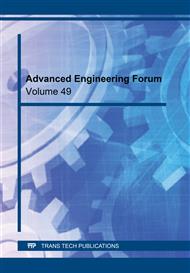[1]
J.S. Kim, D.Y. Kim, A Statistical Analysis of Results of Detailed Inspections on Aged Concrete Erosion Control Dams in Gyeongsangbuk-do, Journal of Korean Society of Forest Science. 111 (2022) 276–286.
Google Scholar
[2]
J.J. Lee, H.S. Yun, Y.H. Kim, S.H. Park, A Study on Development Plan and Derivation of Improvement by Procedure for the Systematization in Steep Slope Management System, Journal of the Society of Disaster Information. 16 (2020) 111-122.
Google Scholar
[3]
C.H. An, J.S. Han, J.B. Hyun, J.K. Choi, H.G. Lee, Comparison of the Effects of Continuous Erosion Control Dams on Benthic Macroinvertebrate Communities Before and After the Rainy Season, Ecology and Resilient Infrastructure. 8 (2021) 54-63.
Google Scholar
[4]
J.H. Lee, S.W. Kim, K.Y. Lee, K.W. Chun, H.S. Bae, Analysis of Factors Affecting Damage of the Concrete Check Dams Based on the Exterior Condition Assessment, Crisisonomy. 17 (2021) 59-72.
DOI: 10.14251/crisisonomy.2021.17.8.59
Google Scholar
[5]
S. K. Choi, J.M. Lee, Y.T. Kim, T.H. Kwon, Characteristics of Trapped Debris by Slit-Type Barriers: Field-Scale Test Results, Korean Soc. Hazard Mitigation. 17 (2017) 261-269.
DOI: 10.9798/kosham.2017.17.5.261
Google Scholar
[6]
Mostafazadeh-Fard, Saman, Dissipating Culvert End Design for Erosion Control Using CFD Platform FLOW-3D Numerical Simulation Modeling, Journal of pipeline systems engineering and practice. 14 (2022) 04022064.
DOI: 10.1061/jpsea2.pseng-1373
Google Scholar
[7]
S.H. Hwang, J.O. Kim, Study on Design Standards for Nature-like Fishway in Korea, Journal of environmental impact assessment. 26 (2017) 181-194.
Google Scholar
[8]
H.J. Kwon, H.G. Kim, Safety estimation of check dam in Muju region according to debris yield, Journal of Korea Water Resources Association. 54 (2021) 915-924.
Google Scholar
[9]
H.S. Cho, B.J. Kim, C.Y. Yune, Experimental Study on the Effect of Arrangement of Cylindrical Countermeasures on Debris Flow Impact Load, Journal of the Korean Geotechnical Society. 36 (2020) 135-148.
Google Scholar
[10]
K.H. Ryou, H.J. Chang, H.J. Lee, A Study on the Flow Characteristics of Debris Flow Using Small-scaled Laboratory Test, Journal of the Korea Academia-Industrial Cooperation Society. 22 (2021) 235-245.
Google Scholar
[11]
S.D. Kim, H.J. Lee, H.J. Chang, The Study for Analysis of Impact Force of Debris Flow According to the Location of Check Dam, Journal of the Korea Academia-Industrial Cooperation Society. 20 (2019) 409-418.
Google Scholar
[12]
Y.H. Kim, K.W. Jun, Analysis of Debris Flow Disaster Area according to Location Change of Check Dam using Kanako-2D, Journal of the Korean Society of Safety. 33 (2018) 128-134.
Google Scholar
[13]
H.G. Kim, B.J. Kim, Nonlinear Impact Analysis for Eco-Pillar Debris Barrier with Hollow Cross-Section, Journal of the Korea Academia-Industrial Cooperation Society. 20 (2019) 430-439.
Google Scholar
[14]
H.Y. Yang, S.J. Lee, S.J. Im, Hydraulic Relation of Discharge and Velocity in Small, Steep Mountain Streams Using the Salt-dilution Method, Journal of korean society of forest science. 107 (2018) 158-165.
Google Scholar
[15]
Hafezolghorani, M, Hejazi, F, Vaghei, R, Jaafar, Karimzade, K, Simplified Damage Plasticity Model for Concrete, Structural Engineering International. 27 (2017) 68-78.
DOI: 10.2749/101686616x1081
Google Scholar


